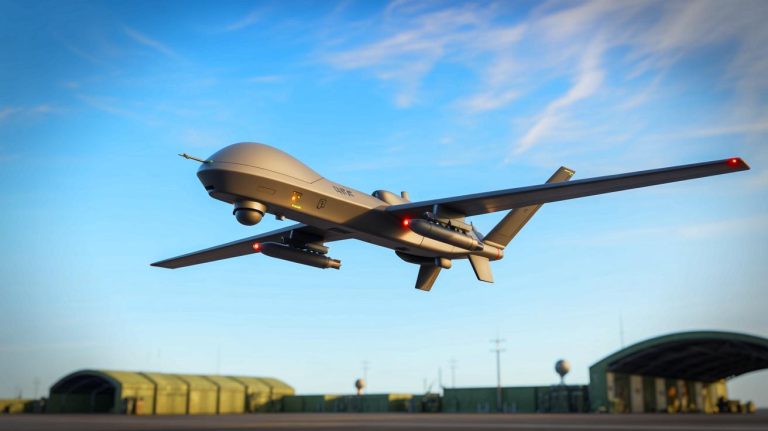| IN A NUTSHELL |
|
The Royal Air Force (RAF) of the United Kingdom has unveiled a groundbreaking innovation in military technology with the introduction of the StormShroud drone. Designed to enhance the effectiveness of crewed aircraft while minimizing risks, this new drone represents a significant leap forward in modern warfare tactics. At the heart of this advancement is the BriteStorm jammer, a lightweight device that uses sophisticated Digital Radio Frequency Memory (DRFM) technology to deceive enemy radar systems. This powerful tool not only jams enemy signals but can also create fake aircraft signals, adding a layer of deception that enhances mission success. As the first in a new family of Autonomous Collaborative Platforms, StormShroud marks a major milestone in the RAF’s strategic evolution.
Advanced Warfare With Drone Wingmen
The advent of the StormShroud drone signifies a pivotal moment in the RAF’s operational capabilities. Based on the Tekever AR3 platform, this drone is manufactured in Wales and Southampton, integrating the BriteStorm electronic warfare payload developed by Leonardo UK. This collaboration ensures that the RAF possesses high-end electronic warfare capabilities without necessitating onboard crew. This autonomy allows military personnel to allocate their focus to other critical missions, enhancing overall operational efficiency.
The AR3 drone boasts impressive specifications, with a range of 62 miles and a weight of up to 55 pounds. Its capacity to fly for up to 16 hours at speeds reaching 56 mph makes it a formidable asset in contested environments. The drone’s compact, rail-launched design facilitates rapid deployment, a crucial factor in dynamic combat scenarios. The RAF’s commitment to this technology is underscored by an initial $25.2 million investment, with future plans to produce hundreds of these drones annually in the UK, further amplifying the nation’s defense capabilities.
Future Combat Begins
StormShroud is pioneering the next generation of Autonomous Collaborative Platforms (ACP), designed to operate in some of the world’s most hostile airspaces. These systems are engineered to work in tandem with traditional fighter jets, significantly enhancing mission success rates while reducing pilot exposure to risks. The primary function of these platforms is to disrupt enemy radar systems and Integrated Air Defence Systems, thereby improving the survivability and effectiveness of crewed aircraft in hostile environments.
The introduction of these uncrewed systems is central to the RAF’s strategy for maintaining technological supremacy over advanced threats. By integrating crewed and uncrewed aircraft, the RAF aims to build a more adaptable, responsive, and cost-effective force. StormShroud draws upon crucial insights gained from recent conflicts, such as those in Ukraine and the Middle East, where Uncrewed Air Systems (UAS) have proven their efficacy in both offensive and defensive roles.
Economic and Strategic Benefits
The StormShroud drone not only enhances military capabilities but also provides significant economic benefits. With Tekever planning to invest an additional $530 million over the next five years, the project is set to create up to 1,000 skilled jobs, bolstering the UK’s defense sector. This investment reflects a strategic commitment to strengthening national security and technological prowess.
Stationed within 216 Squadron, the StormShroud drones will be operated by a team comprising members from the Regular RAF, the Royal Auxiliary Air Force (RAuxAF), and other branches of UK Defense. The squadron will be specially trained to operate in high-threat environments, ensuring that they can effectively deploy the drones in challenging scenarios. This collaborative effort highlights the RAF’s dedication to integrating new technologies seamlessly into existing military frameworks.
The Road Ahead for Military Innovation
The RAF’s introduction of the StormShroud drone is a testament to the relentless pursuit of innovation in military technology. As articulated by Rich Knighton, Chief of the Air Staff, RAF, autonomous collaborative platforms are set to revolutionize missions ranging from intelligence gathering to logistical support. The RAF’s proactive approach, in collaboration with industry partners, ensures that this platform will remain at the forefront of military innovation.
Continuous advancements in tactics and technology are imperative for maintaining an edge over evolving threats. The StormShroud drone exemplifies the RAF’s commitment to strengthening the UK’s defense posture, deterring potential adversaries, and safeguarding national interests. As the RAF continues to explore the possibilities of these platforms, the question arises: How will the integration of such advanced technologies reshape global military strategies in the years to come?
Did you like it? 4.5/5 (28)










Wow, this sounds like something out of a sci-fi movie! Do any other countries have similar tech? 🤔
Is $25.2 million enough to produce hundreds of these drones? Seems like a low budget for military tech.
This is incredible! But how long until other nations catch up? 🚀
Can these drones be used in civilian applications, or are they strictly military?
Did the article mention how these drones are controlled? Autonomous sounds risky. 🤖
Good job, UK! Setting the bar high for military innovations! 🇬🇧
If they can make F-35s invisible, can they make my car fly? 😂
Is this really a sustainable investment for the UK?
Are these drones vulnerable to cyber attacks? 🤔
Does this mean less risk for pilots in combat zones?
Impressive tech! Hope it’s put to good use and not just for war. ✌️
How will this affect the balance of power globally?
Sounds cool, but has this been tested in real combat situations yet?
Seems like a game-changer for aerial warfare. What’s next?
How does the BriteStorm jammer actually work? Seems a bit technical.
Great read! Keep us updated on future developments. 😊
Can these drones be hacked? Security must be tight!
More jobs in the UK is always a good thing! 👏
What stops other countries from developing similar tech?
Hope this doesn’t trigger an arms race. 😟
Why build such advanced drones if we aim for peace? 🤷
Does this tech have any environmental impacts?
So, are these drones completely autonomous or do they need human oversight?
How long before these become obsolete with new tech advancements?
Rival nations must be sweating now! 😅
F35 already claimed to be invisible another lie of course but how does a shitty drone that has a top speed of a lada and garbage flight time keep up with said 5th generation war plane
How many of these drones does the UK plan to produce annually?
What’s the range of these drones, and can they fly undetected for extended periods?
Could this tech potentially be used for non-military purposes, like disaster relief?
Great article! But I’m skeptical about the claimed invisibility. 🤷♂️
Thank you for the detailed article. Very enlightening!
Is this tech exportable, or is it exclusive to the UK?
Can these drones operate in all weather conditions?
The future of warfare is right here! Exciting yet terrifying. 😬
How will the RAF ensure these drones don’t fall into the wrong hands?
Is there any international law governing the use of such advanced drones?
Why is it called StormShroud? Is there a story behind the name?
Will the tech be shared with NATO allies, or is it strictly for the UK?
Are there any known limitations or weaknesses of this technology?
How does this technology compare to what the US and China have?